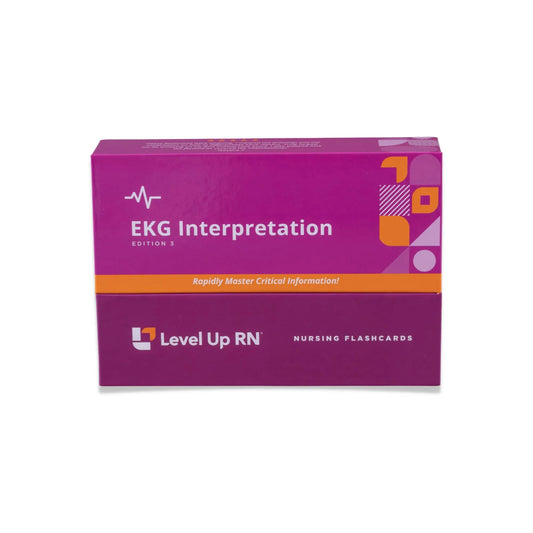In this article, we cover artificial pacemakers, including types of pacemakers and how they look on an EKG, and their synchronicity; and bradycardia and tachycardia along with their causes, symptoms, and interventions, both pharmaceutical and electrical.
The EKG Interpretation video series follows along with our EKG Interpretation Flashcards, which are intended to help RN and PN nursing students study for nursing school exams, including the ATI, HESI, and NCLEX.
EKG Interpretation - Nursing Flashcards
Artificial pacemakers
The heart is made up of natural pacemakers. But if a patient's natural pacemakers fail to maintain a sufficient cardiac output, then they may require an artificial pacemaker. When we refer to pacemakers throughout the rest of this article, we will be discussing the artificial kind!
When you are interpreting an EKG strip, it's important to remember that pacemakers emit a pacing stimuli which will show as a spike.

Types of pacemakers
Pacemakers can provide atrial pacing, ventricular pacing, or both.
Atrial pacing
When the SA node in the heart fails, the patient needs a pacemaker with atrial pacing. When a patient is getting atrial pacing, you will see a spike preceding the P wave.
Ventricular pacing
If a patient has a complete AV block (e.g., a third-degree AV block), they will require a pacemaker with ventricular pacing. When a patient is getting ventricular pacing, you will see a spike prior to the QRS complex.
AV pacing
If a patient has SA node failure and a complete AV block, they will need atrioventricular (AV) pacing (both atrial and ventricular pacing). When a patient is getting AV pacing, you will see both of the above described spikes—one spike preceding the P wave and another spike prior to the QRS complex.
Pacemaker modes
Pacemakers have different synchronicity modes that you should be aware of.
Asynchronous mode
Pacemakers in asynchronous mode fire at a constant rate regardless of the heart's electrical activity. It is not in sync with (or responding to) the heart's activity. On an EKG strip from a patient with an asynchronous pacemaker, you would see pacing spikes before every P wave and every QRS complex.
Synchronous mode
Pacemakers in synchronous mode only fire when the heart's intrinsic rate falls below a certain rate. It is in sync with (responding to) the heart's activity. On an EKG strip from a patient with a synchronous pacemaker, you may see spikes in some part of the strip and not in others. When the spike does not occur, it means the heart was behaving adequately.
Bradycardia
We have discussed bradycardia throughout the EKG series, as many arrhythmias can lead to it. We will cover bradycardia in depth here so you are familiar with the causes, symptoms, and available interventions (pharmaceutical and electrical).
Bradycardia is a heart rate under 60 beats per minute.
Causes
There are a number of causes of bradycardia, many of which we have covered in depth throughout this series. Causes of bradycardia include heart block, sick sinus syndrome, hypothyroidism, medications like digoxin, and electrolyte imbalances like hypermagnesemia.
Other causes of bradycardia can include the Valsalva maneuver, bearing down during a bowel movement, or excess vagal nerve stimulation which can occur with vomiting.
Certainly not all bradycardia is bad. Some people who are very physically fit, like athletes, may have bradycardia. This is because their intense exercise has, over time, trained their heart to become more efficient by circulating the same amount of blood with fewer contractions.
Symptoms
Many patients with bradycardia are asymptomatic, but some patients may experience symptoms like dizziness, syncope (fainting), hypotension, and shortness of breath.
Interventions
If a patient's bradycardia is asymptomatic, they will usually not require an intervention.
Pharmaceutical interventions
If a patient has symptoms with their bradycardia, pharmaceutical interventions can be used, such as atropine, epinephrine, or dopamine.
Electrical intervention
A pacemaker may be needed if a patient does not have sufficient cardiac output due to bradycardia
Tachycardia
We have discussed tachycardia throughout the EKG series, as many arrhythmias can lead to it. We will cover tachycardia in depth here so you are familiar with the causes, symptoms, and available interventions (pharmaceutical and electrical).
Tachycardia is a heart rate over 100 beats per minute.
Causes
Causes of tachycardia can include physical activity (which is an expected finding), anxiety, pain, certain medications, fever, hyperthyroidism, anemia, or as compensation for hypotension.
Symptoms
Some patients with tachycardia may be asymptomatic. If symptoms of tachycardia do occur, they can include shortness of breath, weakness, chest pain, or palpitations.
Interventions
Interventions for tachycardia usually begin with identifying the underlying cause of the tachycardia and addressing that cause. However, there are some pharmaceutical and electrical interventions that can be used for more serious tachycardia dysrhythmias.
Pharmaceutical interventions
There are five classes of antiarrhythmic medications to be familiar with as pharmaceutical interventions for tachycardia. Luckily, these are all covered in our Pharmacology series!
- Class one: sodium channel blockers (procainamide, lidocaine)
- Class two: beta-blockers (propranolol, metoprolol, atenolol)
- Class three: potassium channel blockers (amiodarone)
- Class four: calcium channel blockers (verapamil, diltiazem)
- Class five: other medications (adenosine, digoxin, magnesium sulfate)
If you need to remember these antiarrhythmic medications for Pharmacology exams or the NCLEX, check out our Pharmacology flashcards for nursing students.
Electrical interventions
There are electrical interventions for tachycardia including cardioversion and defibrillation.
Cardioversion can be performed on a patient who has atrial fibrillation, atrial flutter, supraventricular tachycardia, or ventricular tachycardia with a pulse.
For patients who have ventricular tachycardia without a pulse, the required intervention is defibrillation.
Another tachycardia dysrhythmia that requires defibrillation is ventricular fibrillation. Remember that you "defib V-fib."


